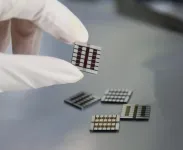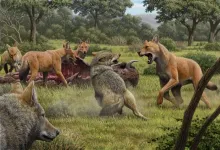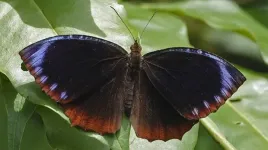(Press-News.org) Scientists in China and Sweden have determined that a pinch of capsaicin, the chemical compound that gives chili peppers their spicy sting, may be a secret ingredient for more stable and efficient perovskite solar cells. The research, published January 13 in the journal Joule, determined that sprinkling capsaicin into the precursor of methylammonium lead triiodide (MAPbI3) perovskite during the manufacturing process led to a greater abundance of electrons (instead of empty placeholders) to conduct current at the semiconductor's surface. The addition resulted in polycrystalline MAPbI3 solar cells with the most efficient charge transport to date.
"In the future, green and sustainable forest-based biomaterial additive technology will be a clear trend in non-toxic lead-free perovskite materials," says Qinye Bao, a senior author of the study from East China Normal University. "We hope this will eventually yield a fully green perovskite solar cell for a clean energy source."
While metal halide perovskite semiconductors represent a promising component for state-of-the-art solar cell technologies, they are plagued by nonradiative recombination, an undesirable electron-level process that reduces efficiency and exacerbates heat losses. Bao and colleagues sought out a natural, forest-based, inexpensive additive to overcome this limitation and enhance solar cell performance.
"Considering the electric, chemical, optical, and stable properties of capsaicin, we preliminarily found that it would be a promising candidate," says Bao.
To test capsaicin's capabilities, Bao and colleagues added 0.1 wt% of the compound (the optimal determined concentration) into a MAPbI3 perovskite precursor, which they used to fabricate solar cells. Next, the researchers performed a series of techniques, including ultraviolet photoelectron spectroscopy, X-ray photoelectron spectroscopy, and time-resolved photoluminescence to determine how the capsaicin additive affected the solar cells' properties. They found that while control devices showed a power conversion efficiency of only 19.1%, devices containing capsaicin had an efficiency of 21.88% - nearly as high as the record 21.93% efficiency of single-crystal MAPbI3 devices. The enhanced solar cells also showed improved stability, maintaining more than 90% of their initial efficiency after 800 hours of storage in ambient air.
Bao and colleagues also determined that capsaicin greatly reduced the perovskite film's defect density, increasing electron density by an order of magnitude and boosting charge transport. Additionally, they observed a smaller leakage current in solar cells containing the chili pepper compound, suggesting it successfully suppressed nonradiative recombination.
Capsaicin enabled these improvements by transforming the perovskite material's surface energetics, creating an interface between p-type semiconductor layers, which contain more electron-deficient "holes" than electrons, and n-type semiconductor layers, which contain more electrons than "holes." This interface promotes charge transport and suppresses the loss of efficiency observed in traditional perovskite semiconductors.
While capsaicin may provide a low-cost, widely available additive for the future development of scaled-up, highly efficient perovskite solar cells, Bao and colleagues note that further research is required to investigate the compound's effect on non-toxic, lead-free perovskites such as inorganic perovskite and double perovskite. Additionally, the material's stability must be further honed before it will be ready for commercial applications.
"We will further focus on the relationship between chemical structures of natural forest-based biomaterial additives, their interaction with photoactive materials, and the corresponding photovoltaic performance," says Bao. "We hope to generate new knowledge of great value to further increase the power conversion efficiency and stability of perovskite solar cells."
INFORMATION:
This work was supported by the National Science Foundation of China, the Fundamental Research Funds for the Central Universities, Shanghai Rising-Star, East China Normal University Multifunctional Platform for Innovation, the Swedish Government Strategic Research Area in Materials Science on Functional Materials at Linköping University, the National Key Research and Development Program of China, and the National Natural Science Foundation of China.
Joule, Hao and Xiong et al.: "Direct observation on p- to n-type transformation of perovskite surface region during defect passivation driving high photovoltaic efficiency" https://www.cell.com/joule/fulltext/S2542-4351(20)30608-5
Joule (@Joule_CP), published monthly by Cell Press, is a new home for outstanding and insightful research, analysis, and ideas addressing the need for more sustainable energy. A sister journal to Cell, Joule spans all scales of energy research, from fundamental laboratory research into energy conversion and storage to impactful analysis at the global level. Visit http://www.cell.com/joule. To receive Cell Press media alerts, contact press@cell.com.
NEW YORK, January 13, 2021 -- Many animal and insect species use Batesian mimicry -- mimicking a poisonous species -- as a defense against predators. The common palmfly Elymnias hypermnestra -- a species of satyrine butterfly that is found throughout wide areas of tropical and subtropical Asia -- adds a twist to this evolutionary strategy. The females evolved two distinct forms, either orange or dark brown, imitating two separate poisonous model species, Danaus or Euploea. The males are uniformly brown. A population group is either entirely brown (both males and females) or mixed (brown males and orange females).
David Lohman, ...
The iconic, prehistoric dire wolf, which prowled through Los Angeles and elsewhere in the Americas over 11 millennia ago, was a distinct species from the slightly smaller gray wolf, an international team of scientists reports today in the journal Nature.
The study, which puts to bed a mystery that biologists have pondered for more than 100 years, was led by researchers from UCLA, along with colleagues from Durham University in the U.K., Australia's Adelaide University and Germany's Ludwig Maximilian University.
"The terrifying dire wolf, a legendary symbol of Los Angeles and the La Brea Tar Pits, has earned its place among the many large, unique species that went extinct at the end of the Pleistocene ...
Mutations that occur in certain DNA regions, called tandem repeats, may play a significant role in autism spectrum disorders, according to research led by Melissa Gymrek, assistant professor in the UC San Diego Department of Computer Science and Engineering and School of Medicine. The study, which was published in Nature on Jan. 14, was co-authored by UCLA professor of human genetics Kirk Lohmueller and highlights the contributions these understudied mutations can make to disease.
"Few researchers really study these repetitive regions because they're generally non-coding--they do not make proteins; their function is ...
Extinct dire wolves split off from other wolves nearly six million years ago and were only a distant relative of today's wolves, according to new research published in Nature today (13 January).
Dire wolves, made famous in the TV show Game of Thrones, were common across North America until around 13,000 years ago, after which they went extinct.
The study shows that dire wolves were so different from other canine species like coyotes and grey wolves that they were not able to breed with each other. Previous analyses, based on morphology alone, had led scientists to believe that dire wolves were closely related to grey wolves.
The research was led by Durham University in the UK alongside scientists at the University of Oxford, Ludwig Maximilian University in ...
New York, NY--January 13, 2021--Researchers at Columbia Engineering report today that they have developed the first nanomaterial that demonstrates "photon avalanching," a process that is unrivaled in its combination of extreme nonlinear optical behavior and efficiency. The realization of photon avalanching in nanoparticle form opens up a host of sought-after applications, from real-time super-resolution optical microscopy, precise temperature and environmental sensing, and infrared light detection, to optical analog-to-digital conversion and quantum sensing.
"Nobody has seen avalanching behavior like this in nanomaterials before," said James Schuck, associate professor of mechanical engineering, who led the study published today by Nature. "We ...
Even computers can miscalculate. Already small disturbances change stored information and corrupt results. That is why computers use methods to continuously correct such errors. In quantum computers, the vulnerability to errors can be reduced by storing quantum information in more than a single quantum particle. These logical quantum bits are less sensitive to errors. In recent years, theorists have developed many different error correction codes and optimized them for different tasks. "The most promising codes in quantum error correction are those defined on a two-dimensional lattice," ...
A new study by researchers at the University of Chicago and the City College of New York (CCNY) has identified a unique, genetic "mimicry switch" that determines whether or not male and female Elymnias hypermnestra palmflies mimic the same or different species of butterflies. The results indicate that sexual dimorphism has repeatedly emerged in different palmfly populations, and linked the trait to a gene associated with melanin localization and regulation.
Published on Jan. 13 in the journal END ...
Red and green algae that grow on snow in the Antarctic Peninsula (AP) cause significant extra snowmelt on par with melt from dust on snow in the Rocky Mountains, according to a first-of-its-kind scientific research study led by Alia Khan, affiliate research scientist at the National Snow and Ice Data Center (NSIDC) and assistant professor at Western Washington University. Algal blooms are likely to increase in Antarctica as the planet continues to warm, which will further exacerbate seasonal snowmelt and contribute to the expansion of ice-free areas in the AP region. This could have serious impacts on regional climate, snow and ice melt, freshwater availability and ecosystems, yet is not accounted for in current global climate models. Results of the research were published on ...
Scientists claim to have found the 'missing link' in the process that leads to an ice age on Earth.
Melting icebergs in the Antarctic are the key, say the team from Cardiff University, triggering a series of chain reactions that plunges Earth into a prolonged period of cold temperatures.
The findings have been published today in Nature from an international consortium of scientists from universities around the world.
It has long been known that ice age cycles are paced by periodic changes to Earth's orbit of the sun, which subsequently changes the amount of solar radiation that reaches the Earth's surface.
However, ...
KU Leuven researchers have identified the biological mechanism that explains why some people experience abdominal pain when they eat certain foods. The finding paves the way for more efficient treatment of irritable bowel syndrome and other food intolerances. The study, carried out in mice and humans, was published in Nature.
Up to 20% of the world's population suffers from the irritable bowel syndrome (IBS), which causes stomach pain or severe discomfort after eating. This affects their quality of life. Gluten-free and other diets can provide some relief, but why this works is a mystery, since the patients are not allergic to the foods in question, nor do they ...






